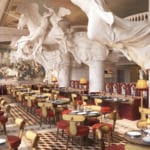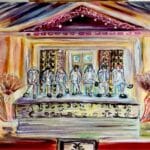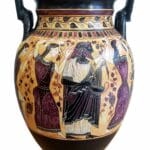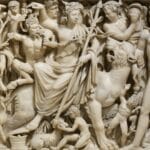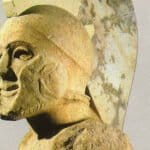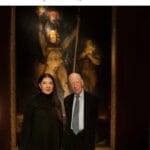Images of Dionysus, the Greek god of wine and revelry, participating in wild feasts have captivated artists for millennia, appearing everywhere from ancient Greek pottery to, most recently, the opening ceremony of the Paris 2024 Olympics. This article delves into the rich history of these artistic depictions, exploring how different artists throughout history have captured the energy and symbolism of these celebrations. By exploring the details of who painted what, when, and why, we will examine the deeper meanings behind these iconic works, and how they reflect their time period, ultimately analyzing the recent controversy surrounding their inclusion in a modern event. Prepare for a journey through art history, connecting centuries-old artistic traditions to a modern spectacle and showcasing the enduring power of artistic ideas.
Unveiling the Wild Side: Dionysian Feasts in Art History
From ancient depictions on Greek pottery to modern interpretations, images of Dionysus and his exuberant feasts have consistently captivated artists and audiences. Let’s journey through history, examining how our understanding of this enigmatic god has evolved.
Early representations, found on ancient Greek pottery and mosaics, often presented Dionysian celebrations with a surprisingly elegant simplicity. Swirling lines, stylized figures, and an emphasis on the shared, ritualistic experience characterized these early works. Recurring symbols—grapes, ivy, and figures in states of ecstatic abandon—laid the groundwork for future artistic interpretations. While not photorealistic, these early images successfully conveyed the feeling of joyous abandon and the shared experience.
The Renaissance witnessed a renewed interest in classical mythology. Artists such as Caravaggio arguably offered a more humanized portrayal of Dionysus in their work, depicting him not as an untouchable deity, but as a flawed, sensual being. This shift likely reflected the humanist ideals of the Renaissance, prompting a re-evaluation of traditional representations of gods and power. His “Bacchus,” for instance, is a striking example of this more realistic and human approach.
The Baroque period amplified the drama, with artists like Jan van Bijlert creating works bursting with vibrant color and dynamic movement. His “Feast of the Gods,” a masterpiece now residing in the Musée Magnin in Dijon, France, epitomizes this exuberant style. The painting, while technically depicting the marriage of Thetis and Peleus, prominently features Bacchus (the Roman equivalent of Dionysus), highlighting unrestrained joy and sensuality. However, the underlying meaning remains open to interpretation. Some might argue it’s purely an aesthetic rendering, while others might suggest a more profound commentary on the nature of excess and celebration.
The symbolism within these paintings is undeniably rich and multifaceted. Grapes and ivy clearly represent fertility and intoxication, but their meaning often shifts depending on the artist and the historical context. Sometimes, the emphasis is on unrestrained celebration and the blending of the human and divine, presenting a powerful image of embracing life’s intoxicating potential. At other times, these symbols may represent a cautionary tale, a reminder that excess can lead to negative consequences.
The inclusion of elements resembling Van Bijlert’s “Feast of the Gods” within the 2024 Paris Olympics opening ceremony sparked significant controversy. This unexpected use of classical imagery prompted a wide range of responses. Was it a celebration of art history or a disrespectful appropriation? The addition of drag queens to the scene further fueled the debate, resulting in diverse and often conflicting interpretations.
The following table summarizes the contrasting viewpoints:
| Aspect | Pro-Ceremony View | Anti-Ceremony View |
|---|---|---|
| Artistic Merit | A creative and inclusive reimagining of classical themes. | A disrespectful and superficial use of historical imagery. |
| Inclusivity | Showcased a diverse range of identities. | An inappropriate blend of mythology and contemporary issues. |
| Overall Impact | A memorable and thought-provoking performance. | Offensive and trivializing; a misrepresentation of ancient mythology. |
This controversy vividly illustrates how differently art can be interpreted, and the inherent challenges of utilizing historical themes in modern art. It underscores the fact that art, particularly when it engages with the past, is almost guaranteed to elicit diverse opinions and spark conversation.
Even today, the imagery of Dionysian feasts continues to resonate with artists. Echoes of these themes persist in contemporary art, film, and popular culture, demonstrating the enduring appeal of the themes of celebration and excess. Their continued relevance suggests something fundamental about the human condition—our inherent desire for pleasure, our capacity for excess, and our need to express ourselves through collective experiences. Ongoing research may shed further light on the evolving meanings and influences of these paintings, potentially even challenging current interpretations. The ongoing study of these artworks is an exciting field ripe with possibilities and a multitude of unanswered questions.
Jan van Bijlert’s “Feast of the Gods”: A Baroque Masterpiece at the Center of the Storm
Many artists throughout history have depicted scenes of Dionysian revelry. However, one painting in particular—Jan van Bijlert’s “Feast of the Gods”—recently found itself at the heart of a significant controversy.
A Closer Look at the Painting
Jan van Bijlert’s “Feast of the Gods,” painted between 1635 and 1640, is currently housed at the Musée Magnin in Dijon, France. While not strictly a “Dionysus feast” in the strictest sense—it depicts the marriage of Thetis and Peleus—Bacchus is a central figure, engaged in the celebratory action. The painting is a vibrant tapestry of detail, depicting a bustling scene bursting with bright colors and dynamic movement. The work elegantly hints at both the chaotic joy and inherent tensions within the mythological wedding celebration.
The Paris 2024 Olympics: A Modern Reinterpretation
The inclusion of a scene visually similar to Bijlert’s masterpiece in the Paris Olympics opening ceremony in July 2024 ignited a firestorm of debate. The tableau, featuring figures resembling Bacchus alongside drag queens, sparked strong reactions. While some lauded it as a bold, inclusive reimagining of classical themes, others viewed it as a disrespectful and vulgar appropriation of religious imagery. The artistic director, Thomas Jolly, stated his intention as a homage, not a slight. The internet erupted with competing narratives. This makes it an unforgettable example of how visual art can become so deeply interwoven with contemporary social and political issues.
A Broader Look at Dionysian Feasts in Art
It’s important to understand that Bijlert’s is not the only artistic attempt to capture the spirit of a Dionysian celebration. Ancient Greek pottery and sculpture offer early examples of these exuberant gatherings, often focusing on the shared ritualistic experience. Later artists also tackled the theme, each adding their own interpretations reflecting the changing cultural values and artistic styles of their time. The remarkable evolution from the restrained elegance of some Renaissance paintings to the unrestrained dynamism of the Baroque style showcases the different artistic approaches to the subject matter. The enduring themes of excess, pleasure, and the connection between the human and divine have echoed through artistic depictions for centuries.
The Continuing Debate: Homage or Appropriation?
The Paris Olympics’ interpretation of Bijlert’s work created a lively debate concerning art, interpretation, and the use of historical images in a modern context. Was it a respectful homage, a playful reimagining, or something more controversial? The ongoing conversation and myriad of online and news articles illustrate the lasting power of ancient myths to inspire reinterpretations and generate intense debate in the present day.
Many Artists, Many Visions
There isn’t one definitive answer to the question of “Who painted a feast of Dionysus?” Numerous artists across centuries have presented their own unique visions of these epic celebrations. Each interpretation reflects the artist’s distinct style and perspective, colored by the cultural and social climate of their time. The 2024 Paris Olympics’ use of Bijlert’s work only serves to underscore this rich artistic history and the lasting impact of these ancient myths in inspiring new discussions and reinterpretations.
Key Points to Remember:
- Bijlert’s Feast of the Gods is a detailed Baroque masterpiece, currently housed in Dijon, France, depicting a mythological wedding feast with a prominent Bacchus figure.
- The Paris 2024 Olympics used a similar scene, sparking massive online debate about artistic intent, respect for historical art, and the inclusion of drag queens.
- Depictions of Dionysian feasts have evolved throughout art history, providing insights into changing cultural values and artistic sensibilities.
- The controversy highlights the enduring power of art to generate discussions, inspire reinterpretations, and provoke unexpected reactions.
- The question “Who painted the feast of Dionysus?” itself demonstrates the diversity of artistic responses to this enduringly resonant theme.
Dionysus Feast Painting
Feast of Dionysus Painting Original
- Conducir Preterite Conjugation: Master the Irregular Verb - November 29, 2024
- Discover Craster Village: Northumberland’s Coastal Gem & Kipper Capital - November 29, 2024
- Eynsford, Kent: Discover the Charm of this Historic Village - November 29, 2024

